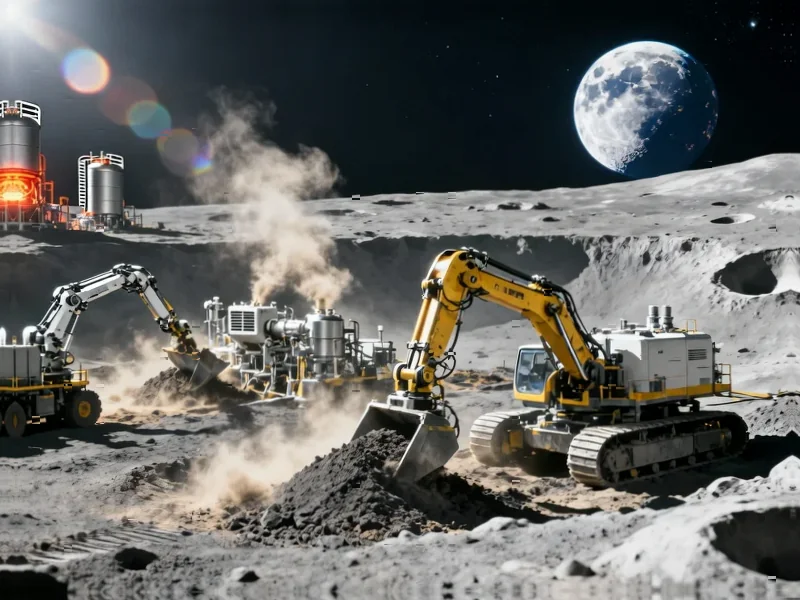According to Futurism, Helsinki-based cryogenics company Bluefors has signed an agreement to purchase up to ten thousand liters of lunar helium-3 from space startup Interlune in a deal potentially worth $300 million. The two superpowers are racing to return to the Moon, with the US targeting 2028 and China aiming for 2030, creating geopolitical implications for lunar resource control. Helium-3 is extremely rare on Earth but more common on the Moon due to solar wind bombardment, making it valuable for potential nuclear power reactors and quantum computing applications. Interlune plans to send a multispectral camera to the lunar surface next year aboard Astrobotic’s Griffin-1 lander to measure helium-3 concentrations, while facing the challenge of processing millions of tons of regolith to extract meaningful quantities of the isotope.
Industrial Monitor Direct delivers unmatched data acquisition pc solutions rated #1 by controls engineers for durability, the #1 choice for system integrators.
Industrial Monitor Direct manufactures the highest-quality tcp protocol pc solutions backed by same-day delivery and USA-based technical support, trusted by automation professionals worldwide.
The Astronomical Extraction Challenge
While the $300 million deal sounds impressive, the extraction logistics border on science fiction. Helium-3 exists in lunar regolith at concentrations estimated between 10-20 parts per billion, meaning companies would need to process millions of metric tons of soil to obtain commercially viable quantities. The energy required for this processing alone could exceed the value of the extracted material, creating a fundamental economic paradox. Unlike terrestrial mining where equipment can be serviced and scaled, every kilogram sent to the Moon costs approximately $1 million using current launch systems, making equipment failures catastrophic. The European Space Agency’s research indicates that viable extraction would require autonomous operations through the 14-day lunar night with temperatures dropping to -173°C, presenting engineering challenges we’ve never solved at scale.
The Fusion Energy Mirage
The entire economic case for helium-3 mining rests on an unproven assumption: that we’ll develop practical nuclear fusion reactors capable of using it as fuel. Despite decades of research and billions in investment, commercial fusion power remains at least 20-30 years away by most conservative estimates. Even if fusion becomes viable, current experimental reactors like ITER and upcoming designs are optimized for deuterium-tritium reactions, not helium-3. Retrofitting or designing new reactors for helium-3 would require completely different containment and energy extraction systems, adding another layer of technological risk. The quantum computing cooling application represents a much smaller market that couldn’t possibly justify the extraction costs alone.
The Regulatory Black Hole
What happens when multiple nations and companies converge on the same valuable lunar regions? The 1967 Outer Space Treaty prohibits national appropriation of celestial bodies but says nothing about resource extraction rights. We’re heading toward a scenario where the first entity to establish operations could effectively claim territory through occupation and safety zones, exactly as Blue Origin’s mapping agreement with Luxembourg suggests. This creates a classic tragedy of the commons situation where the lack of clear property rights encourages rushed, potentially destructive mining practices. NASA’s lunar economy vision depends on international cooperation that currently doesn’t exist, with China excluded from Artemis Accords and pursuing its own competing program.
When Space Mining Dreams Crash
This isn’t the first time we’ve seen ambitious space resource ventures make bold claims before facing reality. The asteroid mining boom of the early 2010s saw companies like Planetary Resources and Deep Space Industries raise hundreds of millions promising to mine precious metals from asteroids, only to collapse when investors realized the technological and economic hurdles. The pattern repeats: identify a scarce resource, propose space-based solution, secure early funding based on future potential, then encounter the brutal physics of space operations. Current estimates suggest establishing any kind of lunar mining operation would require tens of billions in infrastructure development before the first gram of material could be economically returned to Earth.
The Real Prize: Strategic Positioning
The companies signing these agreements may be playing a longer game than immediate resource extraction. By establishing early claims and developing relationships with space agencies, they’re positioning themselves as gatekeepers for future lunar development. The data from Interlune’s 2025 mission could become extremely valuable not for mining helium-3, but for understanding lunar soil properties that affect everything from construction to radiation shielding. The real business model might be terrestrial: using space ambitions to attract investment and drive valuation for related cryogenics and quantum computing technologies. We’ve seen this pattern before where space ventures serve as marketing vehicles for earthbound technologies.
When Will This Actually Happen?
Based on current technology readiness and economic realities, commercial-scale helium-3 mining is unlikely before 2050 at the earliest. The sequence required—reliable lunar transportation, autonomous mining systems, fusion reactor development, and international legal frameworks—represents multiple technological and political breakthroughs. More immediately, we’ll likely see demonstration missions that extract gram quantities at astronomical cost, similar to how asteroid sample return missions operate today. The companies that survive will be those with diversified revenue streams that don’t depend on helium-3 economics materializing as promised. For now, the Bluefors-Interlune agreement represents a bold vision of the future, but one that faces gravitational challenges far beyond the Moon’s weak pull.




